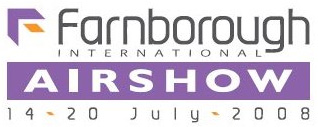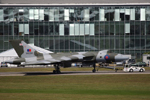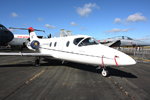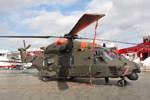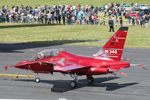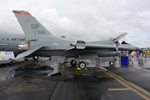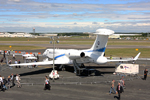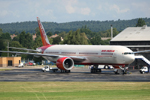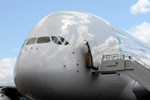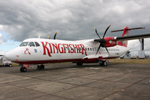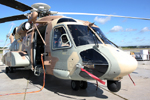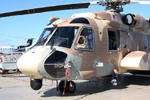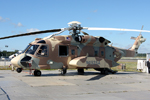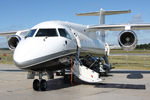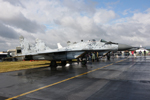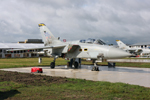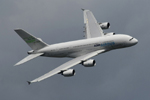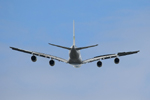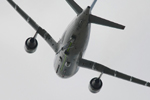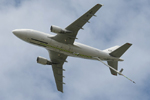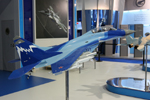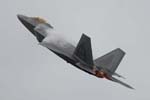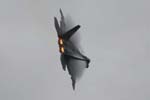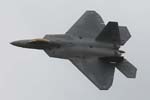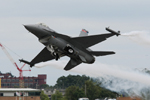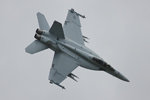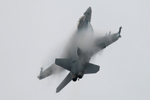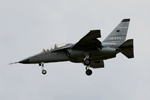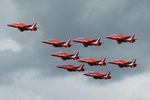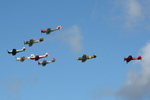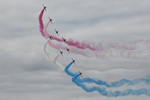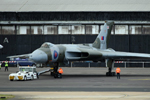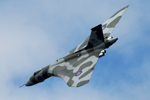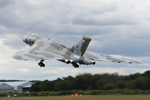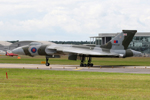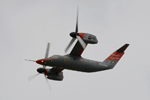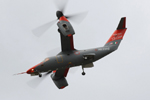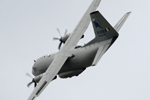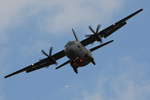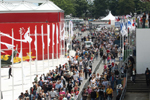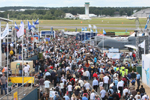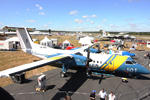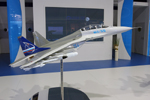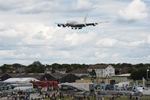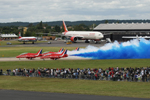When entering the show through what seemed to be quite slick security arrangements that didn’t appear to cause much delay, most people would have been confronted by the small-ish Bell-Textron chalet chocked full with their wares, including the brand spanker Bell 429, and the far more imposing Fortress Finmeccanica – I know the Finmeccanica ‘exhibition’ is eventually opened up to the public, albeit with a MUCH depleted number of aircraft in it, but is it really necessary to restrict access to what is little more than a Finmeccanica-only static park to those whose name is on a list? Surely some or most trade visitors are as interested in having a brief look at the C-27J or EF2000T as someone who perhaps wants to buy an M346 – the deep red coloured example of which, stashed away between the M311 and NH90 was the first production M346. So, obviously, what you do with the first production example of an aircraft is squirrel it away such that, unless you happen to know Mr Guarguaglini personally, you have more chance of skateboarding on Halley’s Comet than you do of actually being able to take a look at the said aircraft, much less photograph it. For reasons best known to Finmeccanica, they seem to just want to make it as difficult as possible… going on the slight change from 2006, by 2012, I wouldn’t bet against all Finmeccanica aircraft and helicopters being behind the kind of wall Hadrian would be proud of. The Finmeccanica family contribution is a fair percentage of the static park (a massive percentage if you were to consider simply military participation) yet it’s probably easier to get into Fort Knox than it is to simply wander around a fenced off area with a camera for five or ten minutes. Finmeccanica staff would undoubtedly have you believe that a camera at an airshow is a security threat! |
|
|
Much less difficult for photography, though still tricky, is the little bit of tarmac and concrete which is basically turned over to the likes of Boeing, Lockheed and the US DoD. Not because there are bouncers and a guest list but because space restrictions dictate aircraft are parked with the use of a crowbar and shoehorn… somewhat understandable when you realise a 777-300ER, 62nd AW C-17A and 815th AS Flying Jennies C-130J plus the smaller aircraft such as the VFA-106 Gladiators F/A-18F, 493rd FS Grim Reapers F-15C, 22nd FS Stingers F-16C and 99th FTS Panthers T-1A, not to mention the full assortment of mock-up weapons, are all parked within the sort of space normally reserved for playing tennis. This particular section of static display also played host to what was arguably one of the stars of the static – an Israeli Air Force Gulfstream G550 Eitam from 122 Nachshon special mission squadron. Sadly not hanging around for the public days, this particular aircraft sports more lumps and bumps than a toad and is a comparatively new addition to Israel’s arsenal, the first two of a handful of Eitams being delivered in February and May. Don’t let it’s relatively small size deceive you – this beastie isn’t some sort of Israeli Sentinel, it’s more to do with what modern electronics has done to the Sentry. Fitted with an advanced third generation Elta/IAI PHALCON system with clever radars and gizmos in the numerous fairing, blisters and big snout, the Eitam is Israel’s 21st century replacement for the E-2C Hawkeye… more fuel efficient and cheaper to maintain than the E-2C, the Eitam provides a long-endurance (enhanced by in-flight refuelling) high-altitude platform with 360º vision and can keep tabs on most potential threats without ever leaving Israeli airspace. |
After kindly being offered a quick look round the inside of Jammu & Kashmir, the pristine Air India 777, it would have been rude to have declined and I’ve now decided first class on an Air India 777-300ER seems to be a rather fine way to travel; business class would do at a push though! It may be the fact that, taking the first flight as its date of birth, this particular jet was the ripe old age of thirteen days old but the cabin really does have to be seen to be believed. Yes, the fancy Bose noise cancelling headphones are quite common amongst a number of airlines in their first or business class cabins but you also get a set of snazzy designer pyjamas to change into if you want and as if the lay-flat seats-that-are-beds aren’t enough, the TV is a little more than interesting. We’ve probably all seen the stuffy little seat-back screens on most airlines so how would a 22” widescreen HD TV with an audio-video on demand system take your fancy? I kid not, each ‘seat’ is set in what can only be described as a cocoon and has its own HD TV that is not all that far short of two foot!! The business class cabin is almost as good but doesn’t have quite the same luxury add-ons although a neat feature, as simple as it may sound, is that each seat has two bottles of water in the back of the seat in front – to stave off dehydration, you have to drink and this way you don’t have to keep summoning over a flight attendant. |
|
|
Rounding out the civilian heavy metal static, in addition to the A380 (of which a bit more slightly later) was the “superjumbo’s” little brother – the A330. The A330-200 parked up in the static was one of India’s Kingfisher Airlines examples, one of just a handful of such aircraft out of an eventual total of twenty in their fleet and, thankfully, in full airline livery. The rest of their jet fleet is an entirely Airbus affair with A319, A320s and A321s – which will be eventually joined by three A340-500s, five A350-800s and five A380-800s for a total jet fleet of ninety-seven jets. For regional flights, Kingfisher rely primarily on the ATR72-500 (an example of which was also in the static display) together with a much smaller number of the smaller ATR42-500. Eventually, their ATR fleet will amount to seventy-three (forty-two ATR72-500s, twenty-three ATR42-600s and just eight ATR42-500s). As a side note, any airline that is just one of six in the world with the full five star rating from Skytrax and whose parent company is a huge brewery - sounds good to me! |
Another little gem, almost swamped by bizjets and the like, in the static park was a Sikorsky S-92 Superhawk complete with a rather fetching Israeli-esque paint job. Roughly the size of a Merlin, the S-92 recipe must go something like a cup of UH-60, a pinch of SH-60 and a tablespoon of CH-53 – elements of each type clearly contribute to the overall design of the S-92. If you just happened to catch a brief glimpse of it, there’s a better than good chance that you may have thought an Israeli CH-53 had come along with the Eitam. It is, however, not quite as new as you might think it is; with a mockup originally unveiled in 1992, Team S-92 launched the helicopter at the 1995 Paris Air Show with the first flight taking place in 1998 although bits were added and lopped off to change the design slightly in 2000. Considering the fact that, thus far, there are more than sixty S-92s in operation with orders for nearly fifty more it’s obviously a competent helicopter although it clearly seems to be favoured by the oil industry or VIP flight operators as opposed to anyone wanting to take one into arms way. So far, the major military customer is Canada who have ordered twenty-eight, as the CH-148 Cyclone, to replace ageing CH-124 Sea Kings. It is, however, as of mid-2008, once again in the running for the $15B 140+ unit USAF CSAR-X programme. |
|
|
The rest of the static wasn’t as bad as it could have been either – during the trade days, the static list was buoyed by the presence of a sizeable number of bizjets such as the Hawker Beechcraft 850XPi, Dornier Do-328-300 and Beech Beechjet 400 (to name just three) which, as is usually the case, disappear by the time it gets round to the public days. Military wise, and Eitam excepted, the stars of the show were probably the two Slovak AF MiG-29s – the single seat MiG-29AS complete with an eye-catching digital camo paintjob and the twin-seat MiG-29UBS with a rather smart grey/black tiger scheme. The “S” suffix essentially means these aircraft have been given a service life extension and updated avionics that are NATO compliant and allow Slovakia to fulfil their commitment to NATO. Doing its very best to upstage the MiG duo was an almost-fully-tooled up XI Squadron Typhoon FGR.4, complete with four Paveway LGBs dangling under the wings. Rounding out the RAF fast jet contingent were a pair of 111(F) Squadron Tornado F.3s, a welcome addition considering the F.3 fleet is on the aviation endangered species list and doesn’t have all that many years left. |
An interesting participant in the static park was the Chrislea CH-3 Super Ace; whilst it can lay justifiable claim to being the oldest aircraft at the show at the ripe old age of sixty, it also happened to be exactly the same aircraft that was at Farnborough’s very first show way back in 1948. A vast amount has changed during its time… back in 1948, it was joined at the show by aircraft such as the Avro Athena I, Avro Lancastrian, de Havilland Dove 1B, de Havilland Vampire F.1 and the first British supersonic aircraft, the de Havilland DH.108. Sixty years on, it is sharing taxiway space with aircraft such as the F/A-18F, MiG-29AS, Tornado F.3 and the Typhoon FGR.4 – aircraft that can’t just go through the sound barrier but can make quite a mess of your day once they’ve done it. Quite what anyone at the show in 1948, slap bang right in the middle of the Berlin Airlift, would have done had you told them not only about what the aircraft at the 2008 show would be capable of but one of them would be a feared Russian aircraft is anyone’s guess. Accused of being a communist spy and sixty years in the Tower of London might not have been out of the question. |
|
Just before the flying display started on Monday, there was to be a race between Lewis Hamilton in his McLaren-Mercedes MP4/23 and a Learjet 60XR. Well, when I say race, it was a race to everyone but Bombardier – and certainly nothing like the Typhoon vs. McLaren battle that the Mail on Sunday would have had you believe. Basically, Lewis sat the McLaren on its 19,000rpm rev limit on the runway centreline and waited for the Learjet to be directly overhead before letting all eight hundred-odd Mercedes horses out to stretch their legs. But it wasn’t a race... it was merely Lewis doing a little bit of work as a Learjet brand ambassador that just so happened to include an F1 car on the runway 200ft below a jet. To everyone watching, it was a race. To Bombardier, it was a spot of advertising by their man Lewis. At least with the jet already in the air, it stood a fighting chance against a car capable of zero to one hundred and back again in about the time it takes to sneeze – Bombardier would have needed the Typhoon if it had been a proper standing-start race. Still, on the back of Lewis’ stunning British GP drive, it was a well enjoyed change from the norm and harks back to the days when Farnborough’s runway was given a going over by Thrust SSC or a Jaguar XJ220. Can we have a proper race next time, please? |
With the exception of the AeroSekur all-girl parachute team (who, to be honest, are actually quite good when the weather plays ball), officially opening the flying display on each day was the A380 which, when it wasn’t being chucked about the sky, was parked up on static display duties not all that far from Fortress Finmeccanica. You wouldn’t want to be a paying passenger on the thing during the display given how it’s flung about and however you look at it, it is an impressive display by an impressive aircraft. Not to mention it’s eerily quiet. How four huge engines can throw out the best part of 300,000lb of thrust and still remain quiet is probably down to whatever magic it is that Rolls-Royce threw into the Trent 900 list of ingredients – it’s a bit noisy on departure but then again the four engines do have a quite a say in hauling about 300 tonnes into the air from a standing start. Yes, it’s an airliner. A big white one at that. But no, it doesn’t get boring to watch. During the Monday display, the transponder was set to a predictive mode which meant its altitude was broadcast based on where the electronics though it was going to be... given a seriously impressive momentary rate of climb, the predicted position was somewhere slap bang in the middle of densely packed airways, way, way above where the A380 actually was. Displays during the rest of the week didn’t cause quite so much panic at Swanwick. |
|
In what is probably a first for me at a UK show, I heard and saw people clapping and cheering when it landed – not quite so much as Paris 2007, but nevertheless, whether it’s because it was a fine performance from the A380 or because people have come to a conclusion that the program is a success, clapping and cheering is clapping and cheering. However, as if the relatively staid and restrained Airbus house colours weren’t bad enough, the jet at Farnborough had its tail redecorated with “A better environment inside and out” on one side with “Airbus A380 See the bigger picture” on the other and large “recyclable by design” stickers on the forward fuselage – boring doesn’t go anywhere near covering it; not to mention it seems to me to be a little ironic. A maximum take off weight of half a small African nation with engines capable of reversing continental drift and it’s supposed to be “green”? Hmmm. Please, please, please Airbus, ignore the tree-hugging eco-warriors and send an A380 in full airline livery to Farnborough 2010 as, though I’m no airline expert, I don’t imagine that the top brass of, say, British Airways had recyclable at the top of priorities when it came to ordering the titan from Toulouse. Fuel burn and efficiency? I’ll give you that one… the fact that you can chop an A380 up in thirty years time and make an untold number of kitchen utensils out of it, I doubt it. |
An interesting participant, during the trade day displays at least, was EADS/CASA’s A310MRTT - the test platform for the EADS flying boom which is fitted to the A330 MRTT / KC-30B. The display isn’t up to much as it’s basically a number of flypasts with the boom lowered; the kicker being that if they’d flown it any higher, they would have probably needed a quick yet in-depth chat with the NASA boys and girls in Mission Control over in Houston. A much more impressive sight would have been to put a “receiver” into the air to simulate refuelling – such as, maybe, an F-16 – as a couple of flypasts with the boom hanging down is not exactly the most inspiring of demonstrations. In light of the political goings-on in Washington surrounding the KC-X tanker deal for the USAF, it’s perhaps a good thing that EADS didn’t unveil an A330MRTT adorned with U.S. Air Force markings on the forward fuselage!! |
|
|
In what can only have been a deliberate scheduling move, Flt Lt Charlie Matthews in the 29(R) Squadron Typhoon F.2 kicked off the relatively short, but somewhat ‘intense’ period of fast jet displays that would feature the Typhoon, the Raptor [on Monday only], the Rhino and the Viper. Sadly neither the Gripen nor Rafale helped pad out the Western numbers, and Russian contribution to the show ran to plastic or rather popular pole dancing models in Hall 1. It would have been nice, especially following the recent announcement about Typhoon air-to-ground capabilities, for a ‘bombed up’ Typhoon to be flung about the Hampshire skies but unlike 2006, 29(R) Squadron took care of all seven displays. Putting on a typically spot-on routine, Charlie put up a strong case for the Typhoon being one of the most agile jets about although the item taking centre stage at 15:08 on the Monday, thus just after the Typhoon, takes the rule book, thumbs through it, rips it up into tiny little pieces then flicks the bits in everyone else’s faces. I can’t help but wonder if the reason for a clean Typhoon was to give it a fighting chance in the inevitable comparisons. |
Fairford should have seen the European debut for what is more than certainly the finest air dominance platform on the face of the planet yet some interesting weather conditions put pay to that idea which meant the F-22 Raptor would technically make its airshow debut at Farnborough. People can argue until they’re blue or purple that they saw Maj. Paul “MAX” Moga display the F-22 at Fairford but that doesn’t count, as Fairford – as far as the show proper goes – was only Saturday and Sunday. It’d be like saying you went to the British Grand Prix yet actually only went to Silverstone for the Friday practice. Hence, the visitors to Farnborough on Monday 14th July were treated to the show debut for the said jet. Staging out of Fairford, the Farnborough display sadly didn’t include the senses-battering take-off but that didn’t really detract from the show although it wasn’t quite the “in-yer-face” display that a show in the US would allow for. A lack of blue skies and sunshine did mean that, rather than dry air, the moisture in the air could be coaxed out; this is something a Raptor can do with one hand tied behind its back and its legs bound together. As a side note, you can blame the insurance people for not letting the F-22 fly at Fairford for those still there on Saturday and Sunday. |
|
|
Even those that had seen the F-22 before stood in utter bewilderment with the rest of the dropped-jawed on-lookers… with the exception of the Russians who are, apparently, not all that impressed by the Raptor and consider the Su-30MKI to be broadly similar. Personally, I suspect someone had probably been at the industrial strength Vodka before they came up with that particular piece of wisdom. I’m of the firm belief it doesn’t matter when, where or how many times you watch this phenomenal display because watching a large, front-line, combat ready jet pull off some of these manoeuvres is truly a sight to behold. Given the gap of about 3 minutes between the Typhoon and the F-22, it made it somewhat easier to compare the two jets – one-nil to the Raptor, then. Very close though. The Typhoon can’t hope to pull off the manoeuvres that need thrust vectoring but the Typhoon is almost up to the Raptor’s standard and in a good ol’ fashioned one-on-one showdown, there’s a good chance it could go either way with phases of the moon, tides and planetary alignment all possibly playing a part. |
Again proving there isn’t a dedicated Demo Raptor, Langley’s 94th FS Hat In The Ring supplied the three jets for the first deployment across the Atlantic (which required eleven visits to the supporting KC-10A and thus gave the demo team guys a number of chances to see their jets being refuelled) for the week long ‘detachment’ to Gloucestershire. An interesting point of comment is that between Fairford and Farnborough, a 493rd F-15C Eagle provided escort for reasons that we won’t confirm although the general theory is to do with the radar return of the F-22, or more specifically, the lack of one. Following up the mighty Raptor was its little brother and Lockheed Martin stablemate, the F-16C. Though it is some way from holding a candle to the F-22, this particular Lockheed flown display is not far off trading blows with the Dutch and Belgians when it comes to showing off the Viper; in this case, the jet was loaned from the Spangdahlem-based 22nd FS Stingers. The main problem was that it seemed just too far away – it doesn’t help that the F-16 is obviously a small jet but at times, it looked little more than a blackbird. |
|
Though a somewhat frequent visitor to our shores, especially where Farnborough is concerned, little was outwardly different about the Super Hornets. VFA-106 Gladiators, the East Coast Fleet Replacement Squadron at NAS Oceana once again provided the actual jets (plus the crews to get them here) and as the lease that Boeing have with the US Navy doesn’t cover APG-79 equipped jets, the two brought to the show were Block II jets with APG-73 radars. However, what was slightly different this time around was that Ricardo Traven wasn’t the sole display pilot – he shared the duties with Steve “BULL” Schmidt. Ricardo flew the display on Monday, Wednesday and Friday and left the flying to Steve on Tuesday, Thursday and both public days. Having flown VIP flights at a number of previous shows (incidentally, Boeing aren’t allowed to demo the radar on these flights), Farnborough was Steve’s first show where he got to fly the display but his credentials are kept in the top drawer. Now a senior experimental test pilot and aircrew integrator for the F/A-18E/F Super Hornet, F-15E Strike Eagle and T-45 Goshawk programmes, during his twenty years of service with the US Navy, Steve has completed numerous F-14A/B Tomcat cruises, completed “TOP GUN” and after graduating from the USN Test Pilot School he went on to serve with VX-4 conducting tests with F-14s and F/A-18s. He has also racked up 3,900 hours on thirty different types and has been involved with the AIM-9X, the Joint Helmet Mounted Cueing System, the X-31 and several classified programs. See what I mean about credentials?! |
Both guys flew the same high display when the weather allowed but on the less than ideal days, Steve flew the standard Boeing low display whereas Ricardo flew a slightly modified version of it. It probably goes without saying just how impressive the display is but should Ricardo be unable to fly for whatever reason, it is now no longer a case of the jet staying firmly on terra firma – Steve Schmidt is just as good and there’s every chance you would find it difficult, if not nigh on impossible, to differentiate between the two pilots (there is a bit of a giveaway but we’ll let you think it through the next time you see a Boeing demo). Sunday’s display, for instance, though restricted to just six minutes or so was absolutely superb and included a few ‘new’ manoeuvres but when Ricardo and Steve can pick and choose from the low, mid and high shows on the fly, that doesn’t come as much of a surprise. |
|
Additional display acts included the Alenia-Aermacchi M346 and HAL Dhruv. Whilst the M346 is a rather tidy looking little jet, its display lacked a little something and wouldn’t really win any awards – but then again, it is early in its life as Europe’s latest lead-in fighter trainer and hopefully more is to come. As far as the Dhruv goes, not only did the Dhruv-equipped team, the Sarangs take to the air during the course of the week, a single Dhruv also had display duties. In this instance, rather than a Peacock scheme, the example used wore a smart Indian Army camouflage scheme and, whilst the Odiham boys don’t have a great deal to worry about, it is fair to say it was thrown around a bit more on its own than part of the Sarang display team. |
Display teams were, as far as Farnborough goes anyway, relatively well represented – no less than three of them in fact. Granted, The Red Arrows were the only military display team to attend but The Blades and, the largest civilian aerobatic team in the work, the Aerostars, were also to feature. As would be expected, the Reds were on their usual top form, the crowd support was unwavering and as usual they managed to get most people doing absolutely nothing but watching their display. As far as The Blades and Aerostars go, such teams aren’t my personal cup of tea but it’d be most unfair to knock the two outfits – The Blades seem to have the upper hand between the two displays, undoubtedly down to the fact that the Extra 300L is a more capable machine than the Aerostars’ Yak-50s but any civilian team that can maintain a 6-ship display deserves respect. Just going back to the Blades for a moment, it perhaps has to be said that the ‘new’ blue and black scheme brought in together with Barclays Commercial sponsorship funds is much more pleasing than the previous orange and black scheme. |
|
|
Probably brought in especially to set a world record for setting off car alarms on Friday, Saturday and Sunday was Crowd Magnet B.2, aka XH558 – it had been a long time since I’d heard all Olympus motors howl and the distinctive engine note certainly brought a number of memories flooding back. A number of years ago I never thought I’d see a Vulcan fly again; I dearly wanted to and had fingers, arms and legs all crossed that the Vulcan To The Sky project would be a success but I had an underlying gut feeling that it’d all go wrong – I couldn’t be more pleased that I was so wide of the mark I was in a different country. It was a great, almost moving, moment to see wind beneath her wings at an airshow again but, as with all great things, there is a bit of a ‘er, well’ side to it and that is that the display isn’t quite up to the RAF display – I’m perfectly happy with the notion of looking after her and a few flypasts are much, much better than nothing at all but I do feel the display needs tweaking a little bit; not by adding anything that would impair the life of the airframe or engines but just adding a topside side would probably be very well received. Still, you could look at it through the wrong end of a telescope and it’s still the world’s one and only flying Vulcan so, I guess, it doesn’t really matter that they don’t fly the wings off it as long as they fly it yet as far as bombers go, the Vulcan wasn’t the only show in town – towards the end of the show timetable, a 28th BS B-1B Lancer would, staging out of RAF Fairford, make a number of flypasts then depart back “home” to Gloucestershire. |
Two more notable inclusions in the flying display came courtesy of Finmeccanica – the Bell-Agusta BA.609 and Alenia C-27J Spartan. The BA.609 tilt-rotor is the world’s first civilian tilt-rotor and, in effect, is a baby V-22 that has been engineered for the VIP role … company executives probably wouldn’t care much for the utilitarian interior of the V-22 but are keen on the ability to land on a rooftop like a helicopter yet get to their next meeting much quicker. Display wise, it is quite a spritely performer although it perhaps couldn’t be considered as much more than an adequate to good enough routine. It does, however, demonstrate its ability to function as both helicopter and aircraft which is why it’s at Farnborough; it’s not there to set the display circuit alight with 9g turns and so on. The C-27J on the other hand was displayed with much more vigour and is certainly up amongst the best when it comes to airlifter displays. The steep climb-out on take off is a seriously impressive trick although with full fuel tanks and packed to bursting with cargo, it’s probably not quite so spritely. Had Airbus been right back in 2006, there should have also been an A400M at the show but, alas, this proved to be such a work of fiction that J. K. Rowling would have been proud – and with the way things are going, there might not even be an A400M at the 2010 show. |
|
What I haven’t yet touched upon was the relatively slick “car park to gate” shuttle bus service. Getting in to the show wasn’t a problem. Getting out to the car park wasn’t a problem. Even with busses full to standing room only, it wasn’t a problem. Getting out of the car park to head home, now, that’s an entirely different proposition. Chris Rhea wasn’t singing about the M25 in The Road To Hell, he was singing about the Farnborough shuttle bus service. I must stress that there was absolutely nothing wrong with the bus service – the issue was the car park. In particular the Queen’s Parade car park. The only signs of marshals, and that’s using the term in its loosest possible sense, were at the gates and why it needed four hundred of them all waving their hands about like they were being swept out to sea is anyone’s guess… if it really needed arm waving, one or two would have done it, not the entire South East supply of yellow-clad marshals. Had you got there early enough to see the sparrows sleeping and thus avoid traffic, you would have kindly been told to park as far away from the exit(s) as was scientifically possible and that meant come the scrum to get home, you were, without putting too fine a point on it, impressively, categorically and thoroughly snookered. What was needed is some degree of control over cars all over the car park, not just at the two exits – we don’t need to be manically waved at and pointed to the exit when the snaking lines of traffic all converging on one point kind of gives the game away. Trade days aren’t an issue. Public days + Vulcan = mayhem. |
In light of the previous week’s incessant rain that ended up causing the cancellation of RIAT, Farnborough seemed to get off lightly although they had demonstrated the secret weapon in the fight against swamps – an area of grass used for car parking had obviously been affected somewhat so the solution was to simple cover the said area with interlocking metal sheets which elegantly circumvented the problem. It did have an element of “Harrier In Germany” about it but, nevertheless, it worked. Due to the lack of use in the preceding days, the grass in the rest of the showground was equally usable although a sizeable proportion of crowdline is on the tarmac/concrete taxiways. Similarly the Queen’s Parade car park appeared, though soft in places, up the task and there didn’t appear to be any weather related issues at all – just as well really as another airshow affected by rain and generally dire weather would have been almost impossible to believe and been quite a heavy blow to the UK airshow industry. |
|
|
One point that never fails to annoy is, even allowing for the fact that entrance to Farnborough is quite cheap for a major show and the region could be considered affluent, the food and drink from the on-site vendors is almost daylight robbery. Quite how anyone can justify the best part of £8 or so for burger and chips is beyond me – and when on-base parking is non-existent, you don’t really want to haul about your supplies for the day so it almost forces you into paying it before you go light headed and fall over. Aside from this, which is an issue prevalent at pretty much any public event you could care to imagine, Farnborough, though not offering up the kind of goodies we’ve been treated to in previous years, was and still is, an airshow worth going to. |
It won’t be long to Farnborough 2010 and by then, Airbus will have hopefully sorted out the A400M ills, Boeing will be ready to send a Dreamliner, the F-22 will hopefully be back, the Typhoon will have a combat tour in Afghanistan under its belt and the weather won’t throw a spanner into any workings. |
|
More photos
| The author would like to extend many thanks to the Farnborough media team, Hayley Dunn of Bombardier, Boeing IDS, Major Paul "MAX" Moga and the F-22 Demo Team and Lewis Hamilton. |

